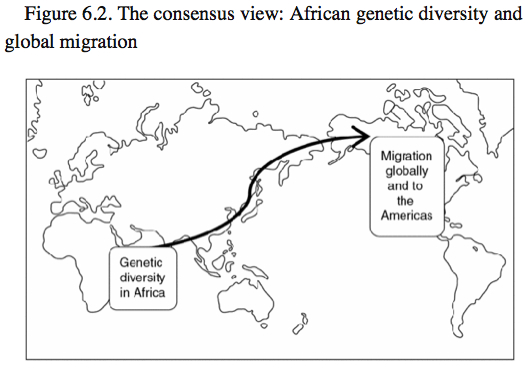
Barnard on Dziebel: Social Anthropology Meets Human Origins
Alan Barnard, a distinguished social anthropologist and a long-time student of Khoisan peoples, has a new book out entitled Genesis of Symbolic Thought. It’s a sequel to his previous study, Social Anthropology and Human Origins, in which he open a dialogue between social anthropologists and the students of human origins. The first book received a chilling response from archaeologist Tim Insoll and biologist Simon Underdown. One can get a sense of the book’s weaknesses by reading a paragraph from Insoll’s review:
“[I]t is sometimes unclear what audience it is being aimed at. If a student one, then it needs more referencing and illustrating. For instance, the omission of a map showing the key sites for finds of hominins needs addressing, whilst statements such as ‘and many still prefer the designation “African Homo erectus” to the separate species name’ (p. 40) inevitably raises the question: who? The relevant references are missing. Similarly, the question that is posed, ‘Did Neanderthals have full language? Probably not’ (p. 94), does not relate to the relevant evidence (e.g. anatomical) or literature, and thus remains essentially open. Equally, if a professional audience is the target, then again some of the argument needs to be in greater depth. Interesting ideas are often proposed but not followed through to the extent that they should be. It is stated that the author read ‘thousands [of publications] in the course of preparing this monograph, but [has] room to discuss and cite only a small percentage’ (p. xii). There is no need to doubt this, but it is a shame that a lengthier treatment was not provided.”
Genesis of Symbolic Thought maintains the same presentation style – it reads like a lecture in which the professor leaves all the details of the topic to his students to explore on their own after class. Nevertheless, Barnard finds the time to discuss my out-of-America theory and offer a couple of graphs (which is flattering considering how image-poor his book is).
Barnard disagrees with my interpretation of the evolution of human kinship systems. By the same token, he disagrees with all other scholars (Claude Levi-Strauss, Nicholas Allen, Mikhail Kryukov and others) who developed evolutionary models of human kinship systems, as they, too, explicitly or implicitly modeled ancestral human kinship structures on ethnographic examples attested outside of Africa. He follows genetic studies in postulating great antiquity behind Khoisans and Pygmies and applies genetic findings to kinship systems. He classifies Khoisan and Pygmy kinship systems as “cognatic Type 1 African” and contrasts them with the derived “structured Type 2 Australian.” But since neither of Barnard’s two books offers details, it remains unclear why exactly Pygmies and Khoisans have ancestral kinship systems, while Australian aborigines and American Indians have derived ones. Pygmy kinship is not much different from the kinship systems of their agricultural neighbors, whereas the Khoisan systems that he discusses in some detail are centered on the important phenomenon of “name transmission” not found in Pygmy kinship systems but shared by such a faraway population as Inuits. By uncritically holding up the mirror to population genetic findings, Barnard falls into the same trap as Victor Grauer with his method of modeling ethnomusicological evolution not on the patterns observed in world music itself but in gene phylogenies. Barnard’s and Grauer’s approach to integrating anthropology with human origins studies is a mimetic one and will hardly lead to deep engagement between disciplines. It’s unlikely that after the many decades of separation of the social sciences – all the disciplines holding a strong focus on understanding the critical part of the differences between humans and earlier hominins – from the biological and archaeological sciences in the area of human origins the latter still managed to “get things right” nonetheless.
It’s regrettable that Barnard doesn’t engage with and apply insights from interpretivist anthropology (including the social studies of science) and critical kinship studies that have challenged, using ethnographic examples, some of the assumptions about human culture and behavior typically made in evolutionary biology. One important paper written in this tradition is Susan McKinnon’s “On Kinship and Marriage: A Critique of the Genetic and Gender Calculus of Evolutionary Psychology” (2005). Human origins research is badly in need of knowledge and methodological sensibilities derived from the social sciences and humanities, as it currently lacks a clear idea of what constitutes “behavioral modernity” (see more here). This gap may be connected to another one, namely the absolute lack of creative, critical and sapient forms of theorizing in human origins research.
This said, Barnard should be commended for being one of the trailblazers in relating social anthropology to human origins research and treading the vast and inscrutable topic of human origins with persistence, erudition and open-mindedness.




[…] (2012) who is exploring the links between social anthropology and modern human origins recently compared my interpretation of kinship and linguistic evidence to the traditional out-of-Africa view. […]